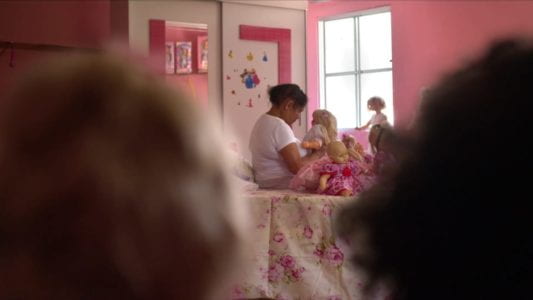
The fear of cinema
The Tiradentes film festival is happening online this year until January 30th, and a good number of the films are screening worldwide with English subs. In the past decade or so, Tiradentes has established itself as one of the main sources of new talent in Brazilian cinema. With a competitive program focused on first-to-third feature films (available for 48 hours online each) – the Mostra Aurora – a short film competition – Mostra Foco – and a few other programs with interesting and often challenging films of all formats (available for the entirety of the festival), Tiradentes has become known for showcasing – and often discovering – the early works of filmmakers such as Adirley Queirós (Aurora winner, 2012); Affonso Uchôa (Aurora winner 2014); Caetano Gotardo; Gabriel Mascaro; Kleber Mendonça Filho; Maria Clara Escobar (Aurora winner 2013); Maya Da-rin; André Novais; Gabriel Martins (Foco winner 2013, alongside Victor Furtado); Luiz Pretti, Ricardo Pretti, Guto Parente, and Pedro Diogenes (Aurora winners 2010); Felipe Bragança and Marina Meliande (Aurora winners 2009) and many others. This year, the program is complemented by a partial retrospective of Paula Gaitán’s work, including three new films.
Açucena, by Isaac Donato, opened this year’s Aurora like an unfulfilled promise. A documentary (although, considering the list of filmmakers above, one should approach this term with caution when in – or virtually in – Tiradentes) about a 67-year old woman who, for religious reasons, celebrates her seventh birthday every year with an ever-growing collection of dolls, the film is quite skillful in establishing a fascinating world where afro-Brazilian religion bends colonial reification toward the sacred.
It’s terrific human material, to the point that the filmmakers themselves seem too enamored with these findings to dare push them anywhere else. Once the physical and sensitive geography of the film is established, Açucena is pregnant with possibilities. There are a number of latent films waiting to be discovered – about these characters, these dolls, these rites… about the political, mystical, and cultural intersections between cinema (with all its colonial history) and underdevelopment – but, instead, the film chooses to stay in the same place, keeping the camera at a safe distance, refusing to mirror the investment of the characters in a symbolic world. Paralyzed by fear before the potential of cinema to honor the complexity of that physical and mystical world, the film ends up draining the power of its characters and situations, dissolving the density of the solutions they have found for their own daily existence into an artificial ethnographic present that is both too cold and not cold enough, as if the dolls were, in fact, just dolls.
* * *

O medo do cinema
Em pouco mais de uma década, a Mostra de Tiradentes se estabeleceu como uma fonte central de novos talentos no cinema brasileiro. Com uma mostra focada em primeiros longas (disponíveis por 48 horas online) – a Mostra Aurora – uma competição de curtas – a Mostra Foco – e outros programas com filmes frequentemente interessantes e desafiadores em diversos formatos (disponíveis por todo o festival), Tiradentes consolidou – e em alguns casos revelou – nomes incontornáveis do cinema brasileiro hoje, como Adirley Queirós (vencedor da Aurora, 2012); Affonso Uchôa (vencedor da Aurora 2014); Caetano Gotardo; Gabriel Mascaro; Kleber Mendonça Filho; Maria Clara Escobar (vencedora da Aurora 2013); André Novais; Gabriel Martins (vencedor da Foco 2013, ao lado de Victor Furtado); Luiz Pretti, Ricardo Pretti, Guto Parente, e Pedro Diogenes (vencedores da Aurora 2010); Felipe Bragança e Marina Meliande (vencedores da Aurora 2009); e muitos outros e outras. Este ano, o programa é complementado por uma retrospectiva parcial de Paula Gaitán, incluindo três trabalhos inéditos.
Açucena, de Isaac Donato, abriu a competição de longas deste ano com uma promessa não cumprida. Um documentário (termo que, levando em conta a lista de cineastas acima, precisa ser usado com cautela) sobre uma senhora de 67 anos que, por motivos religiosos, celebra repetidamente seu aniversário de sete anos cercada por uma crescente coleção de bonecas, o filme é bastante habilidoso em estabelecer um universo cênico fascinante onde as religiões de matriz Africana entortam a reificação colonial rumo ao sagrado.
É um material humano excepcional, a ponto de os próprios cineastas parecerem por demais enamorados com essas descobertas para ousarem levá-las para qualquer outro lugar. Uma vez que a geografia física e sensível do filme é delineada, Açucena oferece diversos filmes latentes – sobre estes personagens, estas bonecas, estes ritos… sobre as intersecções políticas, místicas e culturais entre o cinema (com todo o seu histórico colonial) e o subdesenvolvimento – que ele se nega a explorar, optando por apenas ficar naquele mesmo lugar, com a câmera em uma distância segura, se negando terminantemente a igualar o investimento que seus personagens têm em um mundo simbólico. Paralisado pelo medo do próprio potencial do cinema em honrar a complexidade daquele mundo físico e místico, o filme termina por drenar seus personagens e situações, dissolvendo a densidade das soluções que eles encontraram para sua própria existência na artificialidade de um presente etnográfico que é, ao mesmo tempo, cuja frieza é ao mesmo tempo excessiva e insuficiente, como se as bonecas fossem, de fato, apenas bonecas.






Leave a Reply